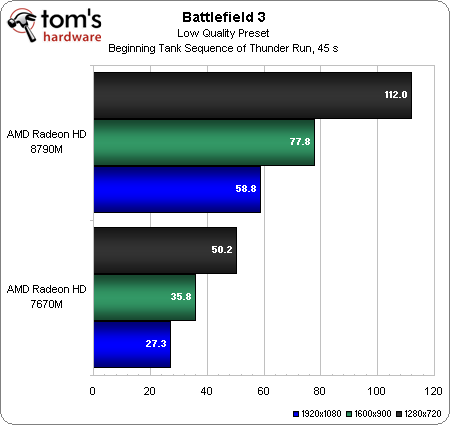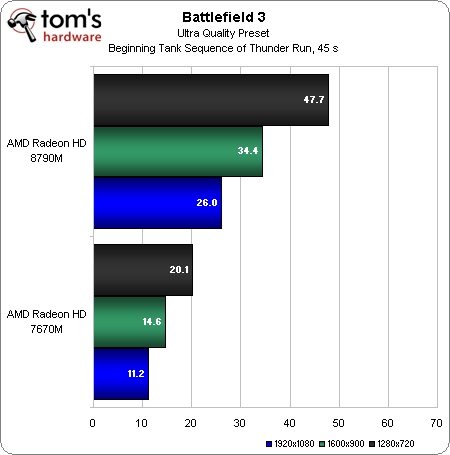AMD Radeon HD 8790M: Next-Gen Mobile Mainstream Graphics Preview
Battlefield 3
Chris Angelini likes to use the Going Hunting mission for testing Battlefield 3 performance. I'm partial to Thunder Run's opening sequence, though. It's slightly more demanding as a result of the sand that gets kicked up by the tanks.

On one end of the spectrum we start with Low quality, establishing that the Radeon HD 7670M only runs smoothly at 1280x720. The older GPU achieves almost 36 FPS on average at 1600x900, but minimums take that resolution as low as 25 FPS.
In comparison, the Radeon HD 8790M delivers between 115 and 125% more performance. AMD's GCN architecture, coupled with aggressive clock rates and plenty of memory bandwidth, combine to drive an average of nearly 60 FPS.

At the other end of the spectrum, AMD's Radeon HD 8790M continues to manage playable frame rates at 1280x720. The situation starts to deteriorate at 1600x900, and 1920x1080 really isn't accessible.
But even at 26 FPS, the 8790M handily outperforms the Radeon HD 7670M at 1280x720. Again, it's hard to know if that's a straight-across comparison, given the lack of power data at our disposal. But knowing that these GPUs are intended to serve the same market, it's at least exciting to see how much more potential will be made available in the year to come.
Get Tom's Hardware's best news and in-depth reviews, straight to your inbox.
Current page: Battlefield 3
Prev Page World Of Warcraft: Mists Of Pandaria Next Page Call Of Duty: Black Ops II-
shikamaru31789 Wow, can't say I expected to see any 8000 series/700 series benchmarks for at least a few months. Looks prettyimpressive for a mobile GPU, can't wait to see what the high end mobile and desktop cards can do.Reply -
A Bad Day Sometimes I wonder why instead of CFing or SLIing two high end mobile GPUs, a desktop GPU would've achieved the same performance but without the stuttering or driver issues.Reply
And if thermal management is an issue, then the desktop GPUs could always be undervolted (but of course more expensive because of the extra step). -
A Bad Day Also, I'm interested to see if the MxM cards of the 8000s are available for retail purchase. I'd like to buy a 15" laptop that supports MxM and is on sale, and swap out the weak GPU.Reply -
Novuake Second review I have seen that uses this module method. Interesting way of doing it. Thanks Toms and AMD.Reply -
mayankleoboy1 Nice preview, Aku and AMD.Reply
Though i suspect you and Chris already have large 'hints' about the HD8000 series performance, but under NDA. -
SteelCity1981 looks like the value brand hit the end of the line with the 7000m series and id expect that with the APU's becoming the standard now for value graphics.Reply -
acku mayankleoboy1Nice preview, Aku and AMD.Though i suspect you and Chris already have large 'hints' about the HD8000 series performance, but under NDA.Reply
In the words of Sgt. Schultz "I know nothing." =_=
Cheers,
Andrew Ku
Tom's Hardware -
amuffin ackuIn the words of Sgt. Schultz "I know nothing." =_=Cheers,Andrew KuTom's HardwareReply
That's what they all say! ;) -
Robert Pankiw A Bad DaySometimes I wonder why instead of CFing or SLIing two high end mobile GPUs, a desktop GPU would've achieved the same performance but without the stuttering or driver issues. And if thermal management is an issue, then the desktop GPUs could always be undervolted (but of course more expensive because of the extra step).Reply
If you look, there is only one chip (shown on this page) which means it is not being CrossFired. I agree that 8780M would be a better name than 8790M. Andrew Ku, maybe on the front page you can clarify this?
About using desktop parts, it is my understanding that they sometimes do exactly that. Take the 7970M, which as far as I can tell, is an 78XX part (I forget which one) except the mobile chip has MUCH higher binning than the desktop 78XX. -
A Bad Day If the 7970M uses two 78XX, why not use a highly binned and undervolted 79XX? Again, better driver stability, more supports from games, more consistent performance scaling, and less micro-stuttering.Reply